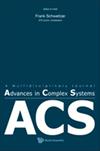具有社区结构和改变属性的自我中心网络球面上改变点的均匀放置(U-PASS)
IF 1
4区 数学
Q4 MATHEMATICS, INTERDISCIPLINARY APPLICATIONS
引用次数: 0
摘要
以自我为中心的网络由一个特定的节点(自我)组成,该节点与网络中所有相邻节点(改变者)都有关系。这种网络是研究自我改变者网络结构的重要工具,将这种网络以良好的可视化方式呈现是至关重要的。本工作旨在引入一种高效的方法,即U-PASS (Uniform Placement of Alters on Spherical Surface),来表示一个以自我为中心的网络,使所有的Alters均匀地分散在单位球面上。U-PASS方法不同于其他单纯考虑节点间欧氏距离最大化的均匀性方法,U-PASS是一种三阶段的方法,它在考虑了改动之间存在的边、节点簇不重叠、节点属性信息的情况下,将改动展开。采用粒子群算法提高节点分配效率。为了保证均匀性,我们在具有特定梯度的二维平面上展示了我们的U-PASS与最小能量设计之间的联系。我们的仿真研究表明,与通过自组织地图和力驱动方法的四种最先进的方法相比,U-PASS在一些距离统计方面表现良好。我们使用Facebook网络来说明,在通过U-PASS分配节点后,这个以自我为中心的网络看起来是如何不同的。本文章由计算机程序翻译,如有差异,请以英文原文为准。
A Uniform Placement of Alters on Spherical Surface (U-PASS) for Ego-Centric Networks with Community Structure and Alter Attributes
An ego-centric network consists of a particular node (ego) that has relationships to all neighboring nodes (alters) in the network. Such network serves as an important tool to study the network structure of alters of the ego, and it is essential to present such network with good visualization. This work aims at introducing an efficient method, namely the Uniform Placement of Alters on Spherical Surface (U-PASS), to represent an ego-centric network so that all alters are scattered on the surface of the unit sphere uniformly. Unlike other simple uniformity that considers to maximize Euclidean distances among nodes, U-PASS is a three-stage method that spreads the alters with the consideration of existing edges among alters, no overlapping of node clusters, and node attribute information. Particle swarm optimization is employed to improve efficiency in node allocations. To guarantee the uniformity, we show the connection between our U-PASS to the minimum energy design on a two-dimensional flat plane with a specific gradient. Our simulation study shows good performance of U-PASS in terms of some distance statistics when compared to four state-of-the-art methods via self-organizing maps and force-driven approaches. We use a Facebook network to illustrate how this ego-centric network looks different after the alter nodes are allocated via our U-PASS.
求助全文
通过发布文献求助,成功后即可免费获取论文全文。
去求助
来源期刊

Advances in Complex Systems
综合性期刊-数学跨学科应用
CiteScore
1.40
自引率
0.00%
发文量
121
审稿时长
6-12 weeks
期刊介绍:
Advances in Complex Systems aims to provide a unique medium of communication for multidisciplinary approaches, either empirical or theoretical, to the study of complex systems. The latter are seen as systems comprised of multiple interacting components, or agents. Nonlinear feedback processes, stochastic influences, specific conditions for the supply of energy, matter, or information may lead to the emergence of new system qualities on the macroscopic scale that cannot be reduced to the dynamics of the agents. Quantitative approaches to the dynamics of complex systems have to consider a broad range of concepts, from analytical tools, statistical methods and computer simulations to distributed problem solving, learning and adaptation. This is an interdisciplinary enterprise.
 求助内容:
求助内容: 应助结果提醒方式:
应助结果提醒方式:


